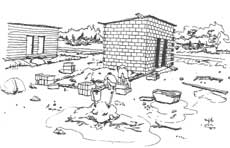|
|||||||||||||||||||||||||
|
|||||||||||||||||||||||||
|
|
|||||||||||||||||||||||||
|
13 de Junho, Brazil |
||||||||||||||||||||||||
| A clear plan for implementation must be prepared and discussed with the community. Particular care must be given if removal and realignment of houses is needed. During the implementation phase, many changes can rapidly occur. Of particular importance are the effects on the families as well as the community: Do land values rise and force families out (displacement)? Is there trickle-down of higher income families (this is related to the overall housing situation)? Is the upgrading attracting informal, uncontrolled development in adjacent areas (spillover) which in turn will need to be upgraded? Who does itOften a special implementation agency designs the project and supervises and monitors implementation. NGOs often play a strong role during the implementation process. In some case s new agency is formed, and in others an existing agency assumes the responsibility. They become the de facto implementation arm of agencies, but in principle provide a bridge between the community and government. In some cases the community acts as the implementor and even the contractor of the components. Time to doThis phase is carried out over many years, often in stages. |
|||||||||||||||||||||||||
|
|
|||||||||||||||||||||||||
Phase III: Carrying It Out
|
|||||||||||||||||||||||||
|
|
|
||||||||||||||||||||||||
|
|||||||||||||||||||||||||

